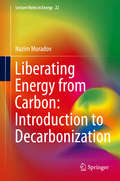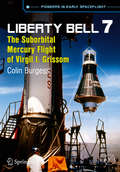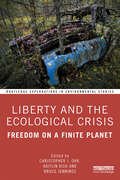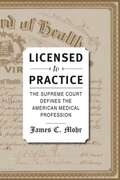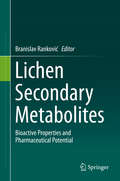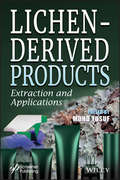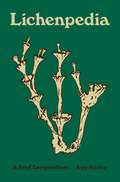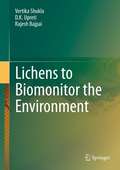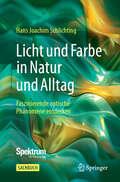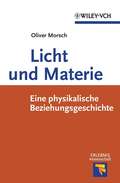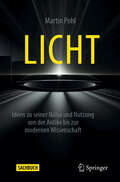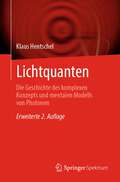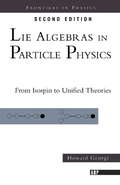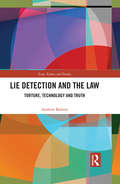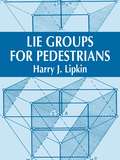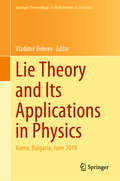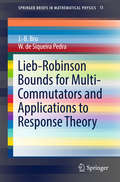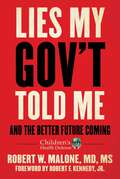- Table View
- List View
Liberating Energy from Carbon: Introduction to Decarbonization
by Nazim MuradovLiberating Energy from Carbon analyzes energy options in a carbon-constrained world. Major strategies and pathways to decarbonizing the carbon-intensive economy are laid out with a special emphasis on the prospects of achieving low-risk atmospheric CO2 levels. The opportunities and challenges in developing and bringing to market novel low and zero-carbon technologies are highlighted from technical, economic and environmental viewpoints. This book takes a unique approach by treating carbon in a holistic manner--tracking its complete transformation chain from fossil fuel sources to the unique properties of the CO2 molecule, to carbon capture and storage and finally, to CO2 industrial utilization and its conversion to value-added products and fuels. This concise but comprehensive sourcebook guides readers through recent scientific and technological developments as well as commercial projects that aim for the decarbonization of the fossil fuel-based economy and CO2 utilization that will play an increasingly important role in the near- and mid-term future. This book is intended for researchers, engineers, and students working and studying in practically all areas of energy technology and alternative energy sources and fuels.
Liberty Bell 7
by Colin BurgessNASA's Mercury astronauts were seven highly skilled professional test pilots. Each of them seemed to possess the strength of character and commitment necessary to overcome apparently insurmountable obstacles as the United States entered into a Cold War space race with the Soviet Union. This was never more evident than on the epic suborbital MR-4 flight of Liberty Bell 7 with astronaut Virgil ('Gus') Grissom piloting the spacecraft to a successful splashdown, followed by the premature blowing of the craft's explosive hatch. After a hurried exit and struggling to stay afloat, he could only watch helplessly as the recovery helicopter pilot valiantly fought a losing battle to save the sinking capsule. That day NASA not only lost a spacecraft but came perilously close to losing one of its Mercury astronauts, a decorated Korean fighter pilot from Indiana who might one day have soared to the highest goal of them all, as the first person to set foot on the Moon. For the first time, many of those closest to the flight of Liberty Bell 7 and astronaut Gus Grissom offer their stories and opinions on the dramatic events of July 21, 1961, and his later pioneering Gemini mission. They also tell of an often controversial life cut tragically and horrifically short in a launch pad fire that shocked the nation.
Liberty and the Ecological Crisis: Freedom on a Finite Planet (Routledge Explorations in Environmental Studies #1)
by Bruce Jennings Christopher J. Orr Kaitlin KishThis book examines the concept of liberty in relation to civilization’s ability to live within ecological limits. Freedom, in all its renditions – choice, thought, action – has become inextricably linked to our understanding of what it means to be modern citizens. And yet, it is our relatively unbounded freedom that has resulted in so much ecological devastation. Liberty has piggy-backed on transformations in human–nature relationships that characterize the Anthropocene: increasing extraction of resources, industrialization, technological development, ecological destruction, and mass production linked to global consumerism. This volume provides a deeply critical examination of the concept of liberty as it relates to environmental politics and ethics in the long view. Contributions explore this entanglement of freedom and the ecological crisis, as well as investigate alternative modernities and more ecologically benign ways of living on Earth. The overarching framework for this collection is that liberty and agency need to be rethought before these strongly held ideals of our age are forced out. On a finite planet, our choices will become limited if we hope to survive the climatic transitions set in motion by uncontrolled consumption of resources and energy over the past 150 years. This volume suggests concrete political and philosophical approaches and governance strategies for learning how to flourish in new ways within the ecological constraints of the planet. Mapping out new ways forward for long-term ecological well-being, this book is essential reading for students and scholars of ecology, environmental ethics, politics, and sociology, and for the wider audience interested in the human–Earth relationship and global sustainability.
Liberty's Grid: A Founding Father, a Mathematical Dreamland, and the Shaping of America
by Amir AlexanderThe surprising history behind a ubiquitous facet of the United States: the gridded landscape. Seen from an airplane, much of the United States appears to be a gridded land of startling uniformity. Perpendicular streets and rectangular fields, all precisely measured and perfectly aligned, turn both urban and rural America into a checkerboard landscape that stretches from horizon to horizon. In evidence throughout the country, but especially the West, the pattern is a hallmark of American life. One might consider it an administrative convenience—an easy way to divide land and lay down streets—but it is not. The colossal grid carved into the North American continent, argues historian and writer Amir Alexander, is a plan redolent with philosophical and political meaning. In 1784 Thomas Jefferson presented Congress with an audacious scheme to reshape the territory of the young United States. All western lands, he proposed, would be inscribed with a single rectilinear grid, transforming the natural landscape into a mathematical one. Following Isaac Newton and John Locke, he viewed mathematical space as a blank slate on which anything is possible and where new Americans, acting freely, could find liberty. And if the real America, with its diverse landscapes and rich human history, did not match his vision, then it must be made to match it. From the halls of Congress to the open prairies, and from the fight against George III to the Trail of Tears, Liberty’s Grid tells the story of the battle between grid makers and their opponents. When Congress endorsed Jefferson’s plan, it set off a struggle over American space that has not subsided. Transcendentalists, urban reformers, and conservationists saw the grid not as a place of possibility but as an artificial imposition that crushed the human spirit. Today, the ideas Jefferson associated with the grid still echo through political rhetoric about the country’s founding, and competing visions for the nation are visible from Manhattan avenues and Kansan pastures to Yosemite’s cliffs and suburbia’s cul-de-sacs. An engrossing read, Liberty’s Grid offers a powerful look at the ideological conflict written on the landscape.
Licensed to Practice: The Supreme Court Defines the American Medical Profession
by James C. MohrHow did American doctors come to be licensed on the terms we now take for granted?Licensed to Practice begins with an 1891 shooting in Wheeling, West Virginia, that left one doctor dead and another on trial for his life. Formerly close friends, the doctors had fallen out over the issue of medical licensing. Historian James C. Mohr calls the murder "a sorry personal consequence of the far larger and historically significant battle among West Virginia’s physicians over the future of their profession."Through most of the nineteenth century, anyone could call themselves a doctor and could practice medicine on whatever basis they wished. But an 1889 U.S. Supreme Court case, Dent v. West Virginia, effectively transformed medical practice from an unregulated occupation to a legally recognized profession. The political and legal battles that led up to the decision were unusually bitter—especially among physicians themselves—and the outcome was far from a foregone conclusion.So-called Regular physicians wanted to impose their own standards on the wide-open medical marketplace in which they and such non-Regulars as Thomsonians, Botanics, Hydropaths, Homeopaths, and Eclectics competed. The Regulars achieved their goal by persuading the state legislature to make it a crime for anyone to practice without a license from the Board of Health, which they controlled. When the high court approved that arrangement—despite constitutional challenges—the licensing precedents established in West Virginia became the bedrock on which the modern American medical structure was built. And those precedents would have profound implications. Thus does Dent, a little-known Supreme Court case, influence how Americans receive health care more than a hundred years after the fact.
Lichen Secondary Metabolites
by Branislav RankovićThe present book discusses in detail the nature and bioactive properties of lichen secondary metabolites. Their therapeutic potential ranges from antibiotic to antioxidant and from anticarcinogenic to antiviral activity. It further discusses their use in traditional medicine and highlights possible future directions in the study of their pharmaceutical potential.
Lichen Secondary Metabolites: Bioactive Properties and Pharmaceutical Potential
by Branislav RankovićThis revised and extended edition provides in-depth insights into the benefits and untapped potential of lichen-derived bioactive compounds. The whole spectrum of these compounds’ biological and medical functions, from antibiotic to antiviral and anti-carcinogenic properties, is presented. In addition, a new chapter discusses the anti-neurodegenerative and anti-diabetic activities of lichenic secondary metabolites. Given its scope, the book offers a valuable asset for students and researchers in this field.
Lichen-Derived Products: Extraction and Applications
by Mohd YusufThe purpose of this book is to provide reference material that includes current developments along with a future outlook on the topic. It is divided into two sections; “Morphological Overview and Extraction Prospects” and “Trends and Applications”. Part I contains four chapters that provide an overview and systematically discuss the physical morphology, suitability and extraction aspects of lichens and their secondary metabolites. Part II includes eight chapters that give in-depth insights on recent and valuable applications of lichen and their obtained products in several applied sectors, including ethnopharmacology, therapeutics, paper and dye, nutraceuticals, cosmetics, herbal industries, etc.
Lichenpedia: A Brief Compendium (Pedia Books #11)
by Kay HurleyAn illustrated mini-encyclopedia about the weird and wonderful world of lichensLichenpedia is a delightfully entertaining and beautifully illustrated A–Z treasury about the strange, obscure, and remarkable world of lichens, from their unique and essential roles in nature and the ways they are used in dyeing, brewing, and drug-making to how they have inspired writers and artists, from Henry David Thoreau to modern painters.In 100 brief entries written in a vivid, lively style, Kay Hurley introduces key aspects of lichen biology, environmental roles, emerging uses, scientific history, and myth. She describes the variety of forms that lichens take, from leafy to filamentous to things reminiscent of skin diseases, with imaginative names like witch&’s hair. She explains the surprising ways that birds and beasts—from reindeer and moose down to tiny tardigrades—use lichens, and how lichens survive in extreme environments, from deserts to Antarctica to outer space. Hurley also introduces some of the innovators who have advanced the knowledge of lichens, from the ancient Greek philosopher Theophrastus to today&’s professional lichenologists.With charming drawings by Susan Adele Edwards, Lichenpedia promises to put you in touch with the natural world in a new way by opening your eyes to these vital organisms, which are all around us, hidden in plain sight.Features a cloth cover with an elaborate foil-stamped design
Lichens to Biomonitor the Environment
by Vertika Shukla Rajesh Bajpai Upreti D. K.The book embodies the detailed account about unique symbionts i.e. LICHENS in ecosystem monitoring. The first chapter deals with unique characteristics features of lichens which facilitate their survival in extreme climates and makes them an ideal organism for ecosystem monitoring. Biosynthesis of secondary metabolites are known to protect lichens against increasing environmental stresses therefore second chapter provides insight into various chromatographic and modern spectroscopic techniques involved in separation and characterization of lichen substances. The third chapter elaborates the criteria for selection of biomonitoring species and characters of host plant that influences lichen diversity and details about different lichen species utilized for biomonitoring. One can retrieve preliminary information about the air quality based on the lichen community structure and distribution of bioindicator species as lichen communities/indicator species provides valuable information about the natural/anthropogenic induced changes in the microclimate and land-use changes due to human activity. Therefore, for identification of species, a key to genera and species provides concise information to identify the lichen species based on their morphological and anatomical characters and chemicals present. Keys provided in Chapter 4 will help the beginners to identify some common lichen species based on the distribution in different climatic zones of India. The section also provides comprehensive information about the bioindicator communities and bioindicator species from India. Chapter 5 provides the details of factors affecting the ecosystem (natural as well as anthropogenic disturbances) and role of lichens in ecosystem monitoring in India has been discussed in detail. Chapter 6 discusses the need and utility of indicator species especially lichen biomonitoring data in sustainable forest management and conservation. The content about lichens in biomonitoring will be a valuable resource for researchers from different fields and will provide an essential reference for people interested in lichens and its role in ecosystem monitoring. The book will also hopefully popularize lichenological studies in India and will generate more active participation of lichen biomonitoring studies in management and conservation of natural resources in India.
Licht in der Welt der Nanotechnologie: Ein verständlicher Einstieg in die Grundlagen und Anwendungen (essentials)
by Christian SchneiderDieses essential gibt einen #65533;berblick #65533;ber die der Nanotechnologie zugrunde liegenden physikalischen Prinzipien, die es heute erm#65533;glichen, mikroskopische Effekte technologisch zu nutzen. Es werden Methoden vorgestellt, welche die Herstellung von Nanostrukturen mit h#65533;chster Pr#65533;zision erlauben. Im letzten Kapitel gibt der Autor einen #65533;berblick #65533;ber spannende technologische Anwendungen, angefangen vom Einsatz von auf Nanotechnologie basierenden Effekten bei Kirchenglasfenstern bis hin zu Solarzellen und CCD-Chips.
Licht und Farbe in Natur und Alltag: Faszinierende optische Phänomene entdecken
by Hans Joachim SchlichtingWir sind umgeben von faszinierenden optischen Phänomenen, die im Alltag meist unbemerkt bleiben. Doch was verbirgt sich hinter den strahlenförmigen Heiligenscheinen, die um den Schatten unseres Kopfes erscheinen, wenn wir in ein trübes Gewässer blicken? Haben Sie jemals die geheimnisvollen Lichtkreuze in Lichtkreisen wahrgenommen, die insbesondere am Morgen oder Abend an Häuserfronten zu sehen sind? Selbst verzerrte Mehrfachspiegelungen auf glänzenden Autokarosserien entgehen den meisten von uns. In diesem Sachbuch nehmen wir Sie mit auf eine Reise durch die Welt der verborgenen Lichterscheinungen. Entdecken Sie Phänomene wie die Quételetschen Ringe, die leuchtenden Glorien im Nebel oder die faszinierenden Strukturfarben von Spinnennetzen, die sich nur aus der passenden Perspektive offenbaren. Selbst bekannte Erscheinungen wie der Regenbogen, der eigene Schatten oder der Heiligenschein im feuchten Gras enthüllen bei genauer Betrachtung völlig neue Details und eröffnen ungeahnte Einsichten. Diese alltäglichen Phänomene werden ohne Formeln physikalisch beschrieben. Dabei erfährt vor allem die ästhetische und erlebnisorientierte Dimension durch reiche Bebilderung und Diktion eine besondere Wertschätzung.
Licht und Materie: Eine Physikalische Beziehungsgeschichte (Erlebnis Wissenschaft)
by Oliver MorschDies ist eine Beziehungsgeschichte, deren Hauptpersonen beim Sonnenbaden eine äußerst wichtige Rolle spielen: das Licht und die Materie. Dass Sonnenlicht unsere Haut wärmen und bräunen kann, wissen wir. Doch Licht und Materie können noch ganz andere Dinge: Wer hätte gedacht, dass Licht nicht nur wärmen, sondern auch kühlen kann? Oder dass man mit gebündeltem Licht nicht nur Löcher ins Papier brennen, sondern auch ganz winzig kleine, einzelne Atome festhalten kann? Und was haben Lichtteilchen mit Geheimcodes zu tun? Oliver Morsch, Physiker und Wissenschaftsjournalist, zeigt Ihnen in diesem kurzweiligen und sehr verständlich geschriebenen Buch, dass viele heutige Errungenschaften und zukünftige Technologien auf den Erkenntnissen der Atomphysik beruhen. Viel Spaß beim Lesen!
Licht: Ideen zu seiner Natur und Nutzung von der Antike bis zur modernen Wissenschaft
by Martin PohlUnsere wohl am weitesten entwickelten Sinnesorgane sind die Augen. Direkt mit dem Gehirn verbunden, speisen die hundert Millionen Lichtrezeptoren unserer Netzhaut geschätzte zehn Megabits pro Sekunde in unser Gehirn ein. So erlaubt uns das visuelle System seit frühester Kindheit, unsere Umwelt zu erfassen und zu interpretieren. Bereits die antiken Naturphilosophen haben sich mit Licht und dem Sehvorgang beschäftigt. Die Entwicklung der Wissenschaft, wie wir sie heute kennen, lässt sich anhand des Leitmotivs Licht gut nachzeichnen. Licht und verwandte Boten geben Auskunft über so faszinierende Phänomene wie die Babyjahre des Universums, Vergangenheit und Gegenwart entfernter Himmelskörper und die Beschaffenheit der mikroskopischen Welt. Sie sind ein Werkzeug in Kosmologie, Astronomie, Teilchenphysik und Medizin. Das Buch analysiert Ideen über Licht – seine Natur, Entstehung und Wirkung – von der griechischen Antike bis heute. Die Wechselwirkung zwischen Theorien, Methodologie, Instrumenten und mathematischen Werkzeugen der jeweiligen Zeit wird beleuchtet. Feuilletonistische Schlaglichter auf Kunst und Kultur machen den Zeitgeist lebendig, vor dessen Hintergrund diese Entwicklungen stattgefunden haben.
Lichtquanten: Die Geschichte des komplexen Konzepts und mentalen Modells von Photonen
by Klaus HentschelDieses Buch besch#65533;ftigt sich mit der Entstehungsgeschichte des komplexen Konzeptes des Photons aus wissenschaftshistorischer, kognitionspsychologischer und naturwissenschaftlicher Sicht. Dabei werden unter anderem sechs verschiedene mentale Modelle des Lichtquantums bzw. Photons diskutiert und der Bogen vom Teilchenmodell Newtons, dem Singularit#65533;tsmodell Einstein und Bohrs bis zum modernen Konzept der Quantisierung des elektromagnetischen Feldes in der Quantenelektrodynamik gespannt. Der Autor besch#65533;ftigt sich zuerst mit der Entwicklungsgeschichte des Photons innerhalb der modernen Physik ab 1900, bevor er die zw#65533;lf semantischen Bedeutungsschichten des Photons ausgehend vom Anfang des 20. Jahrhunderts pr#65533;sentiert. Anschlie#65533;end werden die mentalen Modelle im Laufe der Geschichte bis zur Moderne beschrieben und diskutiert und das heutige Modell des Photons besprochen. Das Buch richtet sich sowohl an Naturwissenschaftler mit physikalischem Hintergrund als auch an Wissenscha ftshistoriker und Andere, die sich mit der Begriffs- und Ideengeschichte von Konzepten auseinandersetzen.
Lichtquanten: Die Geschichte des komplexen Konzepts und mentalen Modells von Photonen
by Klaus HentschelDieses Buch beschäftigt sich mit der Entstehungsgeschichte des komplexen Konzeptes von Photonen aus wissenschaftshistorischer, kognitionspsychologischer und naturwissenschaftlicher Sicht. Dabei werden unter anderem sechs verschiedene mentale Modelle des Lichtquantums bzw. Photons diskutiert. Der Bogen wird vom Teilchenmodell Newtons, dem Singularitätsmodell Einsteins und Bohrs bis zum modernen Konzept der Quantisierung des elektromagnetischen Feldes in der Quantenelektrodynamik gespannt. Der Autor beschäftigt sich zuerst mit der Entwicklungsgeschichte des Photons innerhalb der modernen Physik ab 1900, bevor er zwölf Bedeutungsschichten des Photons ausgehend vom Anfang des 20. Jahrhunderts präsentiert. Anschließend werden die mentalen Modelle des quantisierten Lichts diskutiert und das heutige Modell des Photons besprochen.Die deutlich erweiterte zweite Auflage des Buches wurde unter anderem durch zusätzliche Abschnitte über semiklassische Theorien, Dirac, QED und über die Feynman Lectures ergänzt. Ferner wurde das Kapitel über verschiedene Modelle der Begriffsentwicklung und den hier vertretenen Ansatz der Suche nach mentalen Modellen stark erweitert. Das Buch richtet sich sowohl an Naturwissenschaftler wie auch an Wissenschaftshistoriker und Andere, die sich mit der Begriffs- und Ideengeschichte von Konzepten auseinandersetzen.
Lie Algebras In Particle Physics
by Howard GeorgiGeorgi's Harvard lectures (he's taught physics there since 1980) discuss application of the theory of Lie Algebras and their representations to a wide variety of problems in particles physics and quantum mechanics. This edition has been expanded to include more extensive discussion of finite group theory and representations of the permutation group, as well as discussion of new subjects such as Dynkin indices, spontaneous symmetry breaking, lepton number as a fourth color, and the 27-dimensional representation of E(6). Annotation c. Book News, Inc. , Portland, OR (booknews. com)
Lie Algebras In Particle Physics
by Howard GeorgiHoward Georgi is the co-inventor (with Sheldon Glashow) of the SU(5) theory. This extensively revised and updated edition of his classic text makes the theory of Lie groups accessible to graduate students, while offering a perspective on the way in which knowledge of such groups can provide an insight into the development of unified theories of strong, weak, and electromagnetic interactions.
Lie Algebras In Particle Physics
by Howard GeorgiHoward Georgi is the co-inventor (with Sheldon Glashow) of the SU(5) theory. This extensively revised and updated edition of his classic text makes the theory of Lie groups accessible to graduate students, while offering a perspective on the way in which knowledge of such groups can provide an insight into the development of unified theories of strong, weak, and electromagnetic interactions.
Lie Algebras In Particle Physics
by Howard GeorgiHoward Georgi is the co-inventor (with Sheldon Glashow) of the SU(5) theory. This extensively revised and updated edition of his classic text makes the theory of Lie groups accessible to graduate students, while offering a perspective on the way in which knowledge of such groups can provide an insight into the development of unified theories of strong, weak, and electromagnetic interactions.
Lie Detection and the Law: Torture, Technology and Truth (Law, Science and Society)
by Andrew BalmerThis book develops a sociological account of lie detection practices and uses this to think about lying more generally. Bringing together insights from sociology, social history, socio-legal studies and science and technology studies (STS), it explores how torture and technology have been used to try to discern the truth. It examines a variety of socio-legal practices, including trial by ordeal in Europe, the American criminal jury trial, police interrogations using the polygraph machine, and the post-conviction management of sex offenders in the USA and the UK. Moving across these different contexts, it articulates how uncertainties in the use of lie detection technologies are managed, and the complex roles they play in legal spaces. Alongside this story, the book surveys some of the different ways in which lying is understood in philosophy, law and social order. Lie Detection and the Law will be of interest to STS researchers, socio-legal scholars, criminologists and sociologists, as well as others working at the intersections of law and science.
Lie Groups for Pedestrians
by Harry J. LipkinAccording to the author of this concise, high-level study, physicists often shy away from group theory, perhaps because they are unsure which parts of the subject belong to the physicist and which belong to the mathematician. However, it is possible for physicists to understand and use many techniques which have a group theoretical basis without necessarily understanding all of group theory. This book is designed to familiarize physicists with those techniques. Specifically, the author aims to show how the well-known methods of angular momentum algebra can be extended to treat other Lie groups, with examples illustrating the application of the method.Chapters cover such topics as a simple example of isospin; the group SU3 and its application to elementary particles; the three-dimensional harmonic oscillator; algebras of operators which change the number of particles; permutations; bookkeeping and Young diagrams; and the groups SU4, SU6, and SU12, an introduction to groups of higher rank. Four appendices provide additional valuable data.
Lie Theory and Its Applications in Physics: Varna, Bulgaria, June 2019 (Springer Proceedings in Mathematics & Statistics #335)
by Vladimir DobrevThis volume presents modern trends in the area of symmetries and their applications based on contributions to the workshop "Lie Theory and Its Applications in Physics" held near Varna (Bulgaria) in June 2019. Traditionally, Lie theory is a tool to build mathematical models for physical systems. Recently, the trend is towards geometrization of the mathematical description of physical systems and objects. A geometric approach to a system yields in general some notion of symmetry, which is very helpful in understanding its structure. Geometrization and symmetries are meant in their widest sense, i.e., representation theory, algebraic geometry, number theory, infinite-dimensional Lie algebras and groups, superalgebras and supergroups, groups and quantum groups, noncommutative geometry, symmetries of linear and nonlinear partial differential operators, special functions, and others. Furthermore, the necessary tools from functional analysis are included. This is a large interdisciplinary and interrelated field. The topics covered in this volume from the workshop represent the most modern trends in the field : Representation Theory, Symmetries in String Theories, Symmetries in Gravity Theories, Supergravity, Conformal Field Theory, Integrable Systems, Polylogarithms, and Supersymmetry. They also include Supersymmetric Calogero-type models, Quantum Groups, Deformations, Quantum Computing and Deep Learning, Entanglement, Applications to Quantum Theory, and Exceptional Quantum Algebra for the standard model of particle physics This book is suitable for a broad audience of mathematicians, mathematical physicists, and theoretical physicists, including researchers and graduate students interested in Lie Theory.
Lieb-Robinson Bounds for Multi-Commutators and Applications to Response Theory
by J. B. Bru W. de Siqueira PedraLieb-Robinson bounds for multi-commutators are effective mathematical tools to handle analytic aspects of infinite volume dynamics of non-relativistic quantum particles with short-range, possibly time-dependent interactions. In particular, the existence of fundamental solutions is shown for those (non-autonomous) C*-dynamical systems for which the usual conditions found in standard theories of (parabolic or hyperbolic) non-autonomous evolution equations are not given. In mathematical physics, bounds on multi-commutators of an order higher than two can be used to study linear and non-linear responses of interacting particles to external perturbations. These bounds are derived for lattice fermions, in view of applications to microscopic quantum theory of electrical conduction discussed in this book. All results also apply to quantum spin systems, with obvious modifications. In order to make the results accessible to a wide audience, in particular to students in mathematics with little Physics background, basics of Quantum Mechanics are presented, keeping in mind its algebraic formulation. The C*-algebraic setting for lattice fermions, as well as the celebrated Lieb-Robinson bounds for commutators, are explained in detail, for completeness.
Lies My Gov't Told Me: And the Better Future Coming (Children’s Health Defense)
by Robert W. Malone**AS SEEN ON TUCKER CARLSON TODAY AND THE JOE ROGAN EXPERIENCE**A guide for the times—breaking down the lies about COVID-19 and shedding light on why we came to believe them. When he invented the original mRNA vaccine technology as a medical and graduate student in the late 1980s, Robert Malone could not have imagined that he would become a leader in a movement to expose the dangers of mRNA vaccines that billions of people have received—too often without being informed of the risks. For voicing opposition to the &“mainstream&” narrative, Dr. Robert Malone was censored by Big Tech and vilified by the media. But he continues to speak out and alert the world to the web of lies that we have all experienced. From vaccine safety and effectiveness to early treatments like ivermectin, to lockdowns, masks, and more, Dr. Malone is the signature dissident voice telling the other side of the story about COVID, the role of corporate media, censorship, propaganda, and the brave new world of transhumanism promoted by the World Economic Forum and its acolytes. What effect did the COVID policies have on lives, livelihoods, and democracies? How is it possible that the lies spread by governments would persist, and that our institutions would fail to correct them? Lies My Gov&’t Told Me takes a hard look at these questions and illustrates how data, information, and psychology have been distorted during the pandemic. Governments intentionally weaponized fear to mold behavior. The media smeared anyone who objected to the narrative. And Big Pharma—aligned with larger globalist interests exemplified by the likes of Bill Gates and the World Economic Forum—had captured the agencies that are supposed to regulate it long before the pandemic began. Dr. Malone explores these perverse connections between Pharma, government, and media, and tells us what can be done about it. With contributed chapters from other leading thinkers, such as Dr. Paul Marik and Professor Mattias Desmet, and drawing upon history, psychology, and economics, Lies My Gov&’t Told Me looks at COVID from numerous angles. Never satisfied with a simple answer or easy solution, Dr. Malone proposes multiple action plans for a better future. Dr. Malone calls on each of us to find our own solutions, our own ways to resist the control of fascist, corporatist, and totalitarian overlords. If we are to step out of the darkness—toward a world that defends the principles of the Constitution, upholds individual rights, and honors free speech—we all must play a part in the transition.
